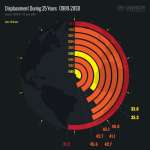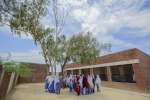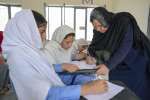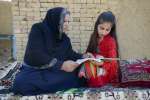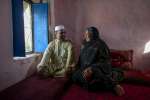Statement by Dr. Auguste R. Lindt, United Nations High Commissioner for Refugees, to the Third Committee of the United Nations General Assembly, 3 November 1958
Statements by High Commissioner, 3 November 1958
In my conversations on my journeys to raise funds for our programmes, I often meet the opinion that refugee problems are ultimately insoluble and that it is as deplorable as it is inevitable that of every given wave of refugees, a certain residue will remain, deteriorating in camps or living a frustrated and unproductive existence outside camps. Our present century provides many examples of this fact.
It seems to me possible to refute this impression of hopelessness. Let us look at the figures in Europe:
| Autumn 1954 | Autumn 1958 | |
| Non-settled refugees within the mandate | 300,000 | 160,000 |
| Of these, in camps | 85,000 | 40,000 |
As far as the 1954 figures are concerned, some refugees represented the residue of pre-World War II problems. The majority, however, were left from the millions of displaced persons and from the refugee streams which had arisen during and in the aftermath of World War II.
In comparing the end-1954 figures with the figures of today, an increase of nearly 300,000 persons in the non-settled population has to be taken into account, the vast majority being newly-arrived refugees, including 200,000 Hungarians. The plain fact is that some 440,000 refugees have found permanent solutions for their problems in the past four years by means of emigration, voluntary repatriation and local integration. The camp population alone has decreased by 45,000 persons. Naturalisation has also to be mentioned as an element of the decrease, in so far as in certain countries naturalisation took place before economic integration had been accomplished. The refugees concerned are no longer under the mandate yet their problems are not solved until they become economically settled.
"The plain fact is that some 440,000 refugees have found permanent solutions for their problems in the past four years by means of emigration, voluntary repatriation and local integration."
The overall reduction in numbers of non-settled refugees is a considerable achievement and all countries of first asylum have benefited by it.
I do not claim that the UNREF programme initiated by my distinguished predecessor and approved four years ago by the General Assembly is directly responsible for more than a small proportion of the general reduction. The result is due to the combination of many efforts: governments of countries of first asylum and resettlement, governments of countries of origin who received voluntary repatriants, the Intergovernmental Committee for European Migration (ICEM), the voluntary agencies, as well as the self-help of numberless refugees. But I believe that the UNREF programme has had a stimulating effect upon the refugee situation. Therein lies its importance.
Apart from its broader effects, UNREF has direct results to report. As UNREF will come to a close at the end of this year, I should like to give a few figures. As of the end of September of this year, the total number of UNREF beneficiaries firmly settled had reached some 26,000. A further 20,000 refugees had benefited from the programme, and 10,000 persons had received supplementary aid. This means a total of 56,000 refugees. This account is not complete, for many projects are still in the course of implementation.
One of the main principles in operating the UNREF programme was to seek supporting contributions from local sources. My Office was always aware that the main responsibility for the refugees lies with the governments of countries of residence, and that international aid must have a supplementary character only. The cost to UNREF of projects financed by 30 September 1958 amounted to some $13 million. Directly identifiable matching contributions from governments or local sources of the countries of residence exceeded $19 million. Every dollar contributed by UNREF was therefore matched by $1.50 by the country of residence.
In tackling the present refugee problems under the mandate, it seems to me important to distinguish between two categories.
The first category is composed of problems which I would like to call "stagnant". The number of the refugees is known and has been reduced to "manageable" proportions; it varies only with deaths and births. An accurate estimate can be made of the kinds of solutions required and their cost. It is also possible to establish a pattern which shows how much aid should and could be provided by national sources, by the refugees themselves, and by international assistance. Definite programmes can be drawn up to solve within a given time problems of this kind. Examples are the Camp Clearance Programme and the Far Eastern Programme. For both, a deadline for their completion has been set.
The considerable problem of refugees out of camp will still need a closer analysis in order to establish programmes which have a definite impact and which are, at the same time, within the limits of financial possibilities.
Into the second category fall problems which I call "dynamic". The extent of the problem is unknown, as it is still developing. Either the influx continues or emigration and repatriation are still taking place at a considerable rate. Emergency measures are required to deal with care and maintenance problems when they go beyond the capacity of the government of the country of first asylum. Solutions have to be worked out. Problems of this kind were dealt with financially outside the UNREF programme, and funds were and are raised on the basis of emergency powers granted to my Office. These problems are not limited to Europe, as my mandate is not regionally confined, but of a global nature.
Camp Clearance
The camp clearance programme is designed to enable a well-defined group of refugees to leave camps. These are the refugees who, when the survey on non-settled refugees was carried out for my Office in mid-1957, were living in camps and were not eligible for aid from other programmes.
The effect of the camp clearance programme will be to abolish camps as places of permanent residence for refugees. Certain camps will continue to serve as transit centres for newly-arrived refugees.
The high priority accorded to this programme is more than justified in terms of the needs, and needs must be the outstanding criterion in international assistance. Although the refugees in those countries with the largest camp populations have equal access with nationals to social benefits – and for this I am very grateful – there are serious handicaps associated with prolonged camp life.
"Needs must be the outstanding criterion in international assistance."
In the first place there is a feeling of isolation from the world. This is not merely because many camps are located in sparsely populated areas. It is also because refugees in camps find that they have no opportunity of contributing both economically and socially to life around them.
Then there is the attitude of hopelessness, the stagnation caused by an expectation of remaining in camps in perpetuity. Refugees who were parents with young children when they entered the camps fourteen years ago now have grandchildren; the younger generations have been reared in the camps, a race apart from the rest of the world. On the other hand, it is the children who inject an element of hope into the situation, for they are young enough to be readily assimilable and they will in due course be capable of supporting the adults who can no longer help themselves – provided that the entire family is helped to leave camp.
Finally, there are the disturbing psychological effects of long years of camp life, resulting in mental disturbances and a high percentage of alcoholic cases. These effects were analysed by the International Congress for Mental Health in Vienna this summer, and the conclusion was reached that the longer the refugees remained in camps, the more difficult it would be to solve their problems.
The combined effect of these three factors associated with prolonged camp life is to produce one of the most tragic of refugee problems.
While the UNREF programme has always given attention to the camp problem, the General Assembly last year requested me to intensify the work of camp clearance, without losing sight of the problems presented by the non-settled refugees living outside camps. Therefore, in those countries where the largest camp populations are located, the 1958 programme has been fully concentrated upon the refugees in camps. Furthermore, the UNREF Executive Committee, acting with the authority conferred upon it by resolution 1166 (XII), has extended the camp clearance programme for the two-year period 1959-1960.
The situation as of 1 July 1957 was that there were 53,400 refugees in official camps in Europe. By 1 July 1958 this number had diminished to 38,400. Of this overall decreased of 15,000, some 6,500 were refugees not included in the camp clearance programme. As far as UNREF is concerned, there were 29,500 eligible refugees in camps at 1 July 1957 and at 1 July 1958, a reduction of 8,500. Of this number, 4,100 were firmly settled outside camps under UNREF projects and the remainder were either enabled to leave the camps through national programmes or were found to fall outside the scope of UNREF due to a closer scrutiny of the list of camps scheduled for clearance.
Present estimates show that at the end of 1958 there will remain in official camps a total of 17,500 refugees. Out of these, 14,000 persons (including handicapped refugees in unofficial camps in Austria) will still be in need of assistance as no provision for then has yet been made. It is for these persons that the 1959-1960 camp clearance programme is designed.
It will be noted that this residual figure of 14,000 is 2,400 higher than the estimate given in the annual report. This is entirely due to the fact that by the end of this year UNREF will be some $900,000 short on its camp clearance programme. Projects to settle the 2,400 refugees concerned have therefore had to be transferred to the 1959 programme.
According to existing plans, the number of 14,000 refugees coming within the scope of the 1959/1960 programmes will be reduced in 1959 by a further 4,000 persons. However, to complete camp clearance by the end of 1960 it will be necessary to increase the 1959 settlement target to from 6,000 to 7,000 persons, leaving the remaining 7,000 to 8,000 persons to be cleared in 1960.
Our plans for 1959 and 1960 exclude single persons and gainfully employed married couples without children, who can be expected to help themselves or who will benefit from national programmes. Indeed, I am counting on governments to continue to implement, in co-ordination with my programme, their own schemes for camp clearance. In the Federal Republic of Germany, for example, it is expected that some 3,400 refugees in camps and who come within this category will be provided with accommodation outside camps without international assistance. My Office will concentrate its attention on the families with children and on the handicapped refugees, for whom complete independence is more difficult to achieve. Our aim is to find an individual solution for each family through the work of counsellors assigned to camps scheduled for clearance. In Austria it has already been possible to plan the individual solutions for the individual families concerned.
Through a natural process, which we try to check as far as possible, it is those refugees who can more easily adapt themselves to life outside the camps who tend to benefit from the early stages of camp clearance. The effect will be to leave in the camps until the last stage a large proportion of cases particularly difficult to settle and particularly in need. I propose to appoint shortly a team of consultants specialized in this type of social problem in order to find out what more can be done to resettle outside camps persons in this category.
Housing is one of the primary needs of refugees in camp. In view of the fact that the camps are widely scattered, only a small number of houses is required in any particular place. It follows from this that the dwellings must take into account the needs and circumstances of the refugees who will occupy them. In effect they must be "made to measure", not only in terms of accommodation but also as regards level of rents, which have to be within the reach of the refugee families now in camps. In Austria, a special housing secretariat attached to my Branch Office is currently taking care of these problems. In the Federal Republic of Germany I recently appointed an expert of international repute to advise on the planning and implementation of the housing projects within the camp clearance programme.
The possibility of completing camp clearance by the end of 1960 is subject to the condition that I receive the necessary funds and that these funds are available to my Office sufficiently early each year to permit work on the projects to begin without delay.
In this connection I would like to stress the importance of the recent Pledging Conference of the Whole Assembly. While it was a matter of some disappointment that only approximately 50% of the sum required for my $60 million programme in 1959 was pledged, planning is being facilitated by the knowledge that some of this money, at least, will become available at the very beginning of the year.
Far Eastern Programme
My Office and ICEM, operating jointly, have been concerned for a number of years with refugees of European origin in the Far East. These refugees have no possibility of becoming integrated in the country of present residence and look to emigration as their main solution. Since 1952, some 11,500 persons have benefited from this joint operation. The number of refugees registered for emigration is today about 10,000. ICEM and my Office have elaborated a three-year programme to bring this problem to a solution.
Last year I had to report to the General Assembly that the situation was critical. ICEM had exhausted its funds for transportation and the operation was threatened with a complete breakdown.
Since then, several governments have made funds available to ICEM with the result that up to this moment over 1,600 refugees have been moved in 1958 to countries of resettlement, chiefly Australia and Brazil. I should like to thank these governments for their generosity. Funds in hand at present will allow the transportation of some further 1,000 refugees to countries of permanent residence.
As 50% of the total group are already in possession of visa assurances, the successful continuation of the operation depends on financing the care and maintenance in Hong Kong and on the availability of transportation funds to ICEM. My conscience is, however, uneasy as the three-year plan means that some of these 10,000 refugees will still have to wait too long for an opportunity to start a new life.
Out-of-Camp Problem
When I presented my annual report to the General Assembly last year, only preliminary results of the survey of the non-settled refugee population in certain countries undertaken for my Office by Professor Idenburg, Director-General of Statistics in the Netherlands, were available. The final report reveals that, in addition to the camp population, there were some 120,000 non-settled refugees in Austria, France, the Federal Republic of Germany, Greece, Italy and Turkey as of mid-summer 1957. This number has not changed to any considerable extent since the survey was made. This out-of-camp problem includes some 32,500 refugees in households affected by physical, social or economic handicaps – an important and distressing fact. With the present essential concentration of effort on camp clearance and unless financial resources are increased, it is not possible to plan for more than a minimum programme for the handicapped categories outside camps. It is in situations like this and because of the limited resources at my disposal that my task of establishing priorities, even among pressing needs of the refugees, becomes invidious. Yet, even small programmes have the indirect effect of stimulating contemporary efforts.
Within the frame of the High Commissioner's programmes for 1959, the UNREF Executive Committee also established an emergency account designed to assist individual cases for whom a solution as defined in the Statute of my Office can be provided.
Special Refugee Problems
New refugees in Europe in general are assisted by the United States Escapee Program, though, being within the mandate, they benefit from the measures of legal protection of my Office. In Italy, which gives asylum to newcomers, the possibilities of integration are very limited due to the economic conditions. Contrary to the general trend in Europe which, as I have said, shows a decrease in the camp population, in Italy this group is increasing year by year and the Government has even been obliged to open new camps. It seems to me that special efforts are indicated as necessary to alleviate the situation.
A number of new refugees have been given asylum in Greece. As this problem is limited in extent and has lost its dynamic character, it has been considered by the Executive Committee, which has authorized a programme for permanent solutions in 1959.
I have drawn attention in my report to two recent refugee question which clearly belong to the second category of problems: one arose as a result of events in 1956 in the Middle East, the other exists in Tunisia. In both cases my Office was called upon to provide international assistance and I was able to make available, directly and indirectly, contributions made for these purposes. The situation is being closely watched by my Office, particularly with a view to directing further international assistance to these groups if the need should arise. As regards the situation in Tunisia,[1] recent reports indicate that despite the valuable action of the League of Red Cross Societies, there is a need to fill certain gaps concerning food and other items. I am now making contacts in this matter, within the frame of the provisions governing the Emergency Fund established with my Office under resolution 1166 (XII).
Though not under my mandate, a resolution of last year's General Assembly recognized the problem of the Chinese refugees in Hong Kong[2] to be of concern to the international community and authorized me to use my good offices to encourage arrangements for contributions. I have drawn the attention of Member States to the resolution and informed them of concrete projects which the Hong Kong Government could implement to the benefit of these refugees. Only a very small amount of money was made available through my Office, while substantial aid reached the refugees through other channels.
Hungarian Refugees
May I give the overall position? Of the some 200,000 Hungarians who left their country, according to figures available to me, 16,700 have voluntarily repatriated from countries of first and second asylum, and some 187,000 have emigrated (47% to European countries and 53% to countries overseas). These latter figures include some duplication as a result of refugees moving from one country to another.
When I had the privilege of addressing the General Assembly a year ago, I mentioned that there were remaining 20,000 in Austria and 3,200 in Yugoslavia. The situation is this:
In Yugoslavia, which had given asylum to some 20,000 refugees, there remains not a single non-settled refugee. The problem was entirely solved within a period of slightly over a year. In the last stages of this operation, countries like Sweden, Norway, Belgium and Switzerland had, by accepting sick and socially handicapped refugees, made it possible to solve in a given country a particular problem without leaving behind any residue or any "hard core". A precedent has been created. It needs to be followed. The Yugoslav Government is left – I should like to stress this – with a deficit of $3,600,000 and I am still trying to remedy this situation.
In Austria, which had given asylum to some 180,000 refugees, the situation is less satisfactory. There remain 15,900, of whom 5,900 are in camps. Compared with a year ago the reduction amounts to 4,300 persons. Of those remaining, some 8,000 wish to emigrate. To these should be added some 400 Hungarians in Italy, where they were given temporary asylum. Thanks to the action of Sweden this summer, which offered permanent asylum to some 200 TB cases, and a similar action by Belgium in favour of 100 difficult cases, the number of handicapped persons in the remaining group is relatively small.
The decision of Australia to accept an additional 1,000 refugees and of the United States to issue a further 3,000 visas to Hungarians in Austria and 300 to Hungarians in Italy will substantially reduce the problem.
For the Hungarians who intend to remain in Austria, my Office has undertaken a $3.5 million permanent solutions programme to assist in their integration. The emphasis is on housing and on small loans to help the refugees start a new existence. The first houses will be ready for occupation at the end of this year. Provision was also made to enable the more gifted among the younger refugees to proceed with their studies at the high school and the university level. This educational assistance is being continued thanks to bilateral funds and the aid of voluntary agencies and foundations.
The Hungarian refugee problem is rapidly changing from the second category into the first one. But instead of passively observing this transformation, would it not be better to make a last effort and solve this relatively small residue of a recent great emergency problem rapidly and completely – as was done in Yugoslavia?
International Protection
While the circumstances surrounding various refugee situations may differ considerably, these situations have in common the fact that they raise a multitude of problems of international protection. This protection is the basic task of my Office. There is the primary question of eligibility, which is resolved in different ways in different countries. There is the need to ensure that refugees are able to obtain travel documents and generally to have a legal status as far as possible equal to that enjoyed by nationals of the country of residence. The right to work needs special mention. The solution of legal protection problems is an essential prerequisite for refugees to find permanent solutions. The number of governments which has ratified or acceded to the international Convention Relating to the Status of Refugees is now twenty-two – one more than last year, I should like to appeal to governments which have not already done so, to consider the possibility of ratifying at an early stage the Convention Relating to the Status of Refugees.
My Office has always been deeply concerned about the difficulties experienced by numbers of refugee seamen in regularizing their status. One example might illustrate their plight. A refugee – Captain Walter Thomson – appealed to my Office for protection after more than a decade of homeless wandering across the oceans of the world. Since 1945 he had served in ships flying the flags of no less than 15 different countries, but none of these states would accept responsibility for issuing him with a travel document or admitting him for permanent residence. When, a few days ago and after considerable efforts in several directions, my Office was able to inform him that the goodwill of the Colombian Government had secured for him the right to reside in Colombia and that an appointment on a Colombian ship was also open, it was already too late, Captain Thomson had died. This short biography of a refugee seaman underlines the significance of an Agreement regulating the status of refugee seamen, unanimously adopted by eight countries at a conference held in The Hague at the end of last year. The Agreement provides general criteria whereby refugee seamen who have no country in which they may lawfully stay shall be issued with a travel document and be accepted in the territory of the state concerned. Although the Agreement has to be ratified by the eight participating governments before it can come into force, a number of the signatory states are already applying its principles. The Agreement is open to accession by other governments, and I commend it to them as a practical expression of international concern for special refugee problem.
I should like to point out that a refugee remains entitled to the international protection of my Office until he has availed himself of the protection of his country of origin or has acquired a new nationality. Until that time my Office has to fulfil this important function, regardless of whether the refugee has been resettled in Europe or overseas or has become integrated in the country of asylum. It will continue to facilitate the return of refugees who voluntarily, without pressure from any side in any direction, express a desire to be repatriated. Questions of family reunion are being dealt with in consultation with the International Committee of the Red Cross, whose traditional task this problem is.
The UNREF Executive Committee at its last session recognized that an increase in protection activities would facilitate the achievement of solutions and would contribute to making these solutions permanent. It therefore recommended that I request for 1960 an increased budgetary allowance for the purpose of expanding legal protection activities.
In addition to legal protection by my Office, refugees are, from time to time, in need of legal advice and assistance in administrative and court proceedings. The UNREF Executive Committee therefore approved a legal assistance programme within the framework of the 1959 programmes.
Emigration
It is the experience of my Office that in most refugee problems a considerable number of refugees want to emigrate. It is my standing policy when seeking permanent solutions to take into consideration the freely-expressed wishes of the refugees. Therefore, during the period under review, I have given much attention to discussing with governments the possibility of reserving a quota for refugees within the overall immigration plans.
A trend towards a more generous approach towards refugees can be discerned. The Australian Government recently agreed to a family reunion scheme for the selection of up to fifty refugee families sponsored by relatives in Australia, who were previously inadmissible on health grounds. The New Zealand Government is ready to grant admission to a group of twenty families, including handicapped persons, now living in refugee camps. Numbers of difficult cases from among the European refugees in the Far East have also been admitted to Australia and New Zealand. Recent legislation in the United States has made it possible to reunite refugee families, even in cases where the relative overseas is afflicted with tuberculosis.
If this trend were to increase, emigration could play a still more important role in solving the refugee problems of the first category.
General Principle
In the approach to my work, whether it concerns legal protection or the seeking of permanent solutions as defined by the mandate, I take as an overriding directive article 2 of the Statute: "The work of the High Commissioner shall be of an entirely non-political character; it shall be humanitarian and social".
World Refugee Year
Finally, I have been requested by the Executive Committee to bring to the attention of the General Assembly a proposal for a World Refugee Year" as a practical means of securing increased assistance for refugees throughout the world, in accordance with the wishes and needs of each country.
[1] See also page 2
[2] See also page 48 below and UNHCR Reference Service No. 5, page 7; and UNHCR reference Service No. 10, page 19.













